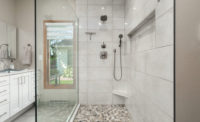The National Kitchen & Bath Association (NKBA) and John Burns Real Estate Consulting’s most recent Kitchen and Bath Market Index Report shows continued demand for residential remodel services, despite the challenges facing the supply chain and ongoing price increases.
In fact, the report shows that 89% of customers are shifting toward pricier items and high-end finishes. Among these increasingly popular higher-end products lies the growing customer desire for smart plumbing — Wi-Fi connected, voice activated and/or touchless — products.
No longer just luxury
The willingness to splurge, along with society's cornerstone focus on wellness, shows that these smart plumbing products are becoming the norm, rather than luxury upgrades.
According to Glenn Rush, designer manager for Build with Ferguson, IoT technology in the kitchen is emergent.
“The term ‘Internet of Things’ (IoT) describes all the physical home devices with a Wi-Fi connection that connect and communicate over a wireless network. In the kitchen, IoT can include an oven, refrigerator, faucet or other devices with Wi-Fi-enabled sensors that improve efficiency, hygiene and safety,” he says. “The future kitchen features intuitive and smart lighting solutions and touchless faucets. These features appeal to a customer’s sense of well-being and security by eliminating additional surface touches. In the future, hands-free fixtures and voice-activated solutions will be considered the norm to limit exposure to viruses and bacteria and increase safety and good health. They will no longer be luxury items.”
Meredith Fingarson, director of marketing for PDI Kitchen, Bath & Lighting showrooms agrees, pointing out that smart plumbing products have helped in her personal life. “As a mother of four, I often reflect on ways smart technology in plumbing has been beneficial to me,” she says. “Touchless or voice activated kitchen faucets for example provide water at a specific temperature, metered dispensing, customer container commands and can be paired with a range of water filtrations systems for clean drinking water — it is a smart work horse in any home.”
In addition to smart products that are visible, such as fixtures and toilets, Tim White, director of marketing for Mountainland Supply, points out there are many connected plumbing products behind the scenes helping homeowners.
“Water heaters, water softeners and filtration systems are all great examples of how smart technology has improved efficiencies and the experience of the users but not in a really visible way. They are often locked in a closet or garage and so we don’t think about them,” he says. “However, with smart technology you can control and set temperatures while home or away, monitor when the optimal time to change out filters, and receive notifications. These aren’t fancy, luxury items, but smart technology has impacted our ability to manage and take care of these products to help them operate better, last longer and be more responsive to personal preferences.”
When it comes to smart toilets, the goal is more about water efficiency and cleanliness than offering a luxury product to customers. According to Jenni Steele, vice president of marketing at Niagara Corp., smart shouldn’t necessarily mean more expensive.
“Smart shouldn’t mean expensive. For example, our vacuum assist toilet, although a little more expensive than an entry level flapper toilet, in the short term, will actually pay for itself and give the owners a large return on their investments. If you look at any low flow toilet, most pay for themselves within a year, giving homeowners a smaller water bill, saving as much as $15 a month, if not more,” Steele explains. “With the emergence of new flush technologies, installers now have a wider range of high-performance toilets and flush volumes needed to fit their needs. These newer options range from 1.6 GPF to 0.8 GPF and thanks to what’s in the tank, the installers can decide which volume best fits their facility.”
Leak detection
Preventing and stopping leaks in the home is an area where smart technology has been around for years and continues to develop.
Brian Postlethwaite, technical sales manager, RDT/FloodMaster, says although the market is largely promoting leak detection devices to residential audiences, he’s seeing more interest developing for smart solutions in commercial properties such as multi-family buildings, office space and medical facilities.
“The residential market is gravitating toward wireless leak detection technologies, with a mix of flow monitoring and sensor-based systems while commercial is a mix of wireless and traditional wired sensors with automatic shut-off technology,” Postlethwaite says. “When commercial applications go with smart leak detection technology, they are often looking for detect and alert systems built around wireless sensors and mobile apps.”
Emily Martis, senior product manager, smart kitchen and bath at Moen agrees, saying smart leak detection products are about peace of mind, not luxury.
“Now more than ever consumers are demanding that technology be incorporated into their lives and into their homes, allowing them to have more control over every day lives. When it comes to smart plumbing it’s all about peace of mind,” she says. “In addition to 24/7 leak monitoring systems, smart sump pump systems offer an extra level of protection. These types of products don’t require your constant attention, but instead are there to inform and protect your home when the time comes.”
Postlethwaite points out that frozen pipes present a major area of concern in the market, and leak detection devices help fill a need for protection in the market. “Frozen pipes are one of the biggest threats to a home or facility, and it is not on the radar of a majority of property owners that frozen pipes are a problem or that there is protection available. It usually takes a signficant water loss for any property owner to start investigating leak protection.”
Leak detection products are evolving to include more and more water monitoring capabilities.
“Smart technologies are evolving every day. One area of growth in the leak protection market is water flow monitoring,” Postlethwaite says. “This technology gives you the ability to analyze water consumption in real-time and take action to conserve water, save money and mitigate damage from plumbing leaks that cause a spike in usage.”
End-user demands
Both distributors and manufacturers say voice activated products are continuing to claim a place in the residential market.
“Voice activated technology is growing at outstanding rates,” says Jacob Reese, sales and operations for Standard Plumbing Supply. “This technology will continue to penetrate our industry and we are already seeing it in many devices. Rinnai’s recirculation tankless water heater is compatible Amazon Alexa as well as the U by Moen, a smart kitchen faucet with voice activation technology.”
White points out that in the kitchen, voice activated appliances are extremely popular, and plumbing products are following suit.
“Smart appliances have really come on in the last year or two. G.E. Appliances have made a real push to use voice-enabled technologies with Alexa, Hey Google, Sonos, and Bose. You can ask Alexa to set your oven to bake without a click of a button or dial turn,” he says.
According to Fingarson, in the showroom, residential customers are interested in personal or automatic cleansing toilets and products with voice commands. “We are seeing products such as Kohler’s DTV+ paired with Kohler Konnect that enhance everyday routines, Kohler’s personal cleansing toilets and seats, such as the Veil Toilet, which are hands free products offering automatic cleansing capabilities,” she says. “We are also seeing the Delta Voice IQ Kitchen faucets become more popular, as it offers voice commanded to dispense a metered amount of water and temperature.”
Steele agrees, stating water conscious toilets with enhanced cleaning capabilities are prevalent in the residential market. “The water conscious HETs are absolutely most popular with a flush volume under 1.28 GPF, and in general, those with a powerful flush. Most people want to utilize the newer models of toilets that include advanced technology like vacuum-assisted flush to ensure that their fixtures are high performing,” she explains. “There has been a past stigma that toilets that use less water are less hygienic, and especially in this fourth wave of the pandemic, end-users want to be sure that their fixtures are clean. Technology like the vacuum-assisted flush paired with the right kind of design that includes a larger water spot, is important for a clean bowl and flush.”
End-users and specifiers continue to reach for touchless and hands-free faucets. According to data from Moen, internet searches for terms like “touchless faucet” and “hands-free faucet” are up nearly 200 percent in pay-per-click campaigns since the previous year.
In addition to touchless, customers are reaching for facuets with additional smart features. "Smart faucets can bring added convenience and customization to daily routines and seamlessly integrate with your current smart home systems," Martis says. "Smart faucets with voice activation technology help reduce the spread of dirt and germs. A 'wash hands' command helps encourage more complete handwashing. Once activated, the water turns on, then pauses for 20 seconds while a user scrubs their hands, then turns back on when it’s time to rinse. These faucets also offer features such as the ability to dispense amounts of water as small as one tablespoon and as large as 15 gallons at a specific temperature."
The ongoing focus on health and wellness has also led to an increase of specifications of smart showers and steam sytems for the home, according to Patrick Weidl, director of business developent for ThermaSol. "The use of voice-activated products and integrated control tablets which can be programmed to provide very precise settings (light, sound, music, water temperature and duration) are becoming the norm," he says. "There is also the ability to add in-shower steam and waterproof speakers which don’t involve any additional equipment and can be incorporated into any shower design."
Again pointing to the notion that smart plumbing products are not just luxury items. "If a homeowner is renovating their bathroom, the overall cost of a smart shower amortized against the benefits of a truly personalized experience should never be considered a luxury," Weidl explains. "The voice-activation aspect means that it is in fact, a must-have rather than a want-to-have, particularly as more people are staying in their homes and aging in place."
Smart technology of the future
Like any aspect of technology, smart plumbing trends are evolving daily.
Fingarson says she expects a focused on sensory experiences to emerge. "Smart technology to heighten sensory experiences — maybe a chronotherapy experience — in showers or bathing space may be the nest big thing to come," she says. "There are products available today that offer a wide range of smart experiences, the true opportunity is understanding our customer and providing
the experiences that they do not know exist that fit their lifestyle goals."
White expects predictive smart technology and AI will take the lead in the smart product space. "As water, gas, oil, plastics and mined materials become more and more scarce it is going to get more costly to operate with the products of old. This is a great opportunity for a revolution of remodeling, of re-building and building in a new way," he says. "Homeowners, business owners, and country, state, and local governments will be using data and technology to monitor our sanitation and water supplies like we’ve never seen before. We will be able to predict how user’s behavior in and out of the home affect the greater population and help consumers to make better decisions for themselves."












